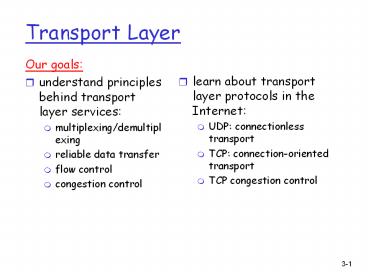Transport Layer PowerPoint PPT Presentation
Title: Transport Layer
1
Transport Layer
- learn about transport layer protocols in the
Internet - UDP connectionless transport
- TCP connection-oriented transport
- TCP congestion control
- Our goals
- understand principles behind transport layer
services - multiplexing/demultiplexing
- reliable data transfer
- flow control
- congestion control
2
Outline
- Transport-layer services
- Multiplexing and demultiplexing
- Connectionless transport UDP
- Principles of reliable data transfer
- Connection-oriented transport TCP
- segment structure
- reliable data transfer
- flow control
- connection management
- Principles of congestion control
- TCP congestion control
3
Transport services and protocols
- provide logical communication between app
processes running on different hosts - transport protocols run in end systems
- send side breaks app messages into segments,
passes to network layer - rcv side reassembles segments into messages,
passes to app layer - more than one transport protocol available to
apps - Internet TCP and UDP
4
Transport vs. network layer
- Household analogy
- 12 kids sending letters to 12 kids
- processes kids
- app messages letters in envelopes
- hosts houses
- transport protocol Ann and Bill
- network-layer protocol postal service
- network layer logical communication between
hosts - transport layer logical communication between
processes - relies on, enhances, network layer services
5
Internet transport-layer protocols
- reliable, in-order delivery (TCP)
- congestion control
- flow control
- connection setup
- unreliable, unordered delivery UDP
- services not available
- delay guarantees
- bandwidth guarantees
6
Outline
- Transport-layer services
- Multiplexing and demultiplexing
- Connectionless transport UDP
- Principles of reliable data transfer
- Connection-oriented transport TCP
- segment structure
- reliable data transfer
- flow control
- connection management
- Principles of congestion control
- TCP congestion control
7
Multiplexing/demultiplexing
delivering received segments to correct socket
gathering data from multiple sockets, enveloping
data with header (later used for demultiplexing)
process
socket
8
How demultiplexing works
- host receives IP datagrams
- each datagram has source IP address, destination
IP address - each datagram carries 1 transport-layer segment
- each segment has source, destination port number
- host uses IP addresses port numbers to direct
segment to appropriate socket
32 bits
source port
dest port
other header fields
application data (message)
TCP/UDP segment format
9
Connectionless demultiplexing
- When host receives UDP segment
- checks destination port number in segment
- directs UDP segment to socket with that port
number - IP datagrams with different source IP addresses
and/or source port numbers directed to same socket
- Create sockets with port numbers
- DatagramSocket mySocket1 new DatagramSocket(9911
1) - DatagramSocket mySocket2 new DatagramSocket(9922
2) - UDP socket identified by two-tuple
- (dest IP address, dest port number)
10
Connectionless demux (cont)
- DatagramSocket serverSocket new
DatagramSocket(6428)
SP provides return address
11
Connection-oriented demux
- TCP socket identified by 4-tuple
- source IP address
- source port number
- dest IP address
- dest port number
- recv host uses all four values to direct segment
to appropriate socket
- Server host may support many simultaneous TCP
sockets - each socket identified by its own 4-tuple
- Web servers have different sockets for each
connecting client - non-persistent HTTP will have different socket
for each request
12
Connection-oriented demux (cont)
S-IP B
D-IPC
SP 9157
Client IPB
DP 80
server IP C
S-IP A
S-IP B
D-IPC
D-IPC
13
Connection-oriented demux Threaded Web Server
P4
S-IP B
D-IPC
SP 9157
Client IPB
DP 80
server IP C
S-IP A
S-IP B
D-IPC
D-IPC
14
Outline
- Transport-layer services
- Multiplexing and demultiplexing
- Connectionless transport UDP
- Principles of reliable data transfer
- Connection-oriented transport TCP
- segment structure
- reliable data transfer
- flow control
- connection management
- Principles of congestion control
- TCP congestion control
15
UDP User Datagram Protocol RFC 768
- no frills, bare bones Internet transport
protocol - best effort service, UDP segments may be
- lost
- delivered out of order to app
- connectionless
- no handshaking between UDP sender, receiver
- each UDP segment handled independently of others
- Why is there a UDP?
- no connection establishment (which can add delay)
- simple no connection state at sender, receiver
- small segment header 8 bytes
- TCP header 20 bytes
- no congestion control UDP can blast away as fast
as desired
16
UDP more
- often used for streaming multimedia apps
- loss tolerant
- rate sensitive
- other UDP uses
- DNS
- SNMP
- reliable transfer over UDP add reliability at
application layer - application-specific error recovery!
32 bits
source port
dest port
Length, in bytes of UDP segment, including header
checksum
length
Application data (message)
UDP segment format
17
UDP checksum
- Goal detect errors (e.g., flipped bits) in
transmitted segment
- Sender
- treat segment contents as sequence of 16-bit
integers - checksum addition (1s complement sum) of
segment contents - sender puts checksum value into UDP checksum
field
- Receiver
- compute checksum of received segment
- check if computed checksum equals checksum field
value - NO - error detected
- YES - no error detected. But maybe errors
nonetheless? .
18
Internet Checksum Example
- Note
- When adding numbers, a carryout from the most
significant bit needs to be added to the result - Example add two 16-bit integers
1 1 1 1 0 0 1 1 0 0 1 1 0 0 1 1
0 1 1 1 0 1 0 1 0 1 0 1 0 1 0 1 0
1 1 1 0 1 1 1 0 1 1 1 0 1 1 1 0 1
1 1 1 0 1 1 1 0 1 1 1 0 1 1 1 1
0 0 1 0 1 0 0 0 1 0 0 0 1 0 0 0 0
1 1
wraparound
sum
checksum

